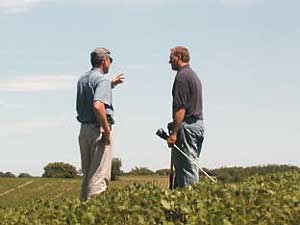|
Audio
Photos
Resources
Your Voice
|
Extension Service announces cuts
July 21, 2003
The University of Minnesota Extension Service is consolidating its operations. Extension officials have selected 18 Minnesota cities as regional Extension centers, to replace the 91 Extension offices currently located in each county in the state. Extension officials say the move is necessary because of cuts in state funding.
Meeker County, Minn. — For more than 90 years, the University Extension Service has had at least one office in all of Minnesota's 87 counties. But now they'll be replaced with 18 regional centers.
Locations for the regional centers were announced Monday. In southern Minnesota, they'll be located in Worthington, Albert Lea, Mankato, Rochester and Marshall.
In addition to the Extension staff on campus at the University of Minnesota, there will be two regional offices in the metro area -- in Andover and Farmington.
 | |||
In central Minnesota, centers will be in Hutchinson, St. Cloud, Mora, Morris, Fergus Falls and Brainerd.
In northern Minnesota, Cloquet, Moorhead, Crookston, Grand Rapids and Roseau will house regional centers.
David Werner, director of the Extension's southwestern Minnesota district in Lamberton, says it was a tough day for those communities that wanted to be a part of the regional system.
"When you have 109 communities that have expressed interest, and you then name 18 as regional centers, you have 18 communities that are very excited and pleased, and you have roughly 90 that are right now experiencing some disappointment," says Werner.
The Extension Service is scaling back because of cuts in state funding. Extension Director Chuck Casey says paying for an Extension office in every county is no longer possible.
"We're going to have to do that in a different way than we've done in the past," says Casey.
This is not the first reorganization at the Extension Service. In 2000, the service cut its workforce by 15 percent. Casey says once again, a money-saving move is needed.
 | |||
"So what we're trying to do is make sure that we're structured in a way that we can continue to deliver programs to people across the state of Minnesota," Casey says.
Casey admits some counties that have always had their own office won't get the same kind of service. But he says each county has the option of keeping their Extension office open, if they pay for it themselves. Currently, counties fund a portion of their local Extension office.
Minnesota farmers will likely miss that personal service, like Keith Landwehr, who farms near Watkins in central Minnesota. Landwehr raises 250 acres of soybeans in the fields surrounding his white farmhouse, but he's got a problem. Some of his soybeans have tattered leaves and he suspects insects are causing the damage.
Landwehr has called Dave Schwartz, the Extension agent from Litchfield, to take a look. It doesn't take long for Schwartz to analyze the problem. It's the recent rains, Schwartz says, combined with wind and a little hail, that caused the leaves to tear. Dave Scwhartz spends the next two hours with Landwehr. They walk through fields, stopping occassionally to dig up soybean roots.
For Landwehr, visits by Extension agents are a great help. He's 28, and has farmed on his own for only a few years.
 | |||
"It would be trial and error from day one. For me to pick up a previous 60, 70 years experience without having to do trial and error -- that's a huge benefit," Landwehr says.
As helpful as they are, these types of on-farm agent visits will happen less often in the future because of the budget cutbacks. Dave Schwartz says the new regional approach will be a challenge for the Extension.
"Extension has been a great resource in the past, and I think it'll be a good resource in the future. But it bothers me a little bit that we can't do all the things that we've done in the past," Schwartz says.
A number of Extension employees will be reassigned to the new centers. But there won't be enough positions in the regional offices for all employees. Those left out of the new centers will have until November to negotiate a position in a satellite office with their county government.
Extension officials say they want to switch to the new system without any layoffs. They can offer early retirement to some employees if they need to reduce the workforce.
Dave Schwartz is not sure what he'll do. Litchfield, where Schwartz has worked for 20 years, was not picked as a regional center.
"I guess I was hoping I would be able to work at a regional center not too far away -- maybe Litchfield would be selected as a site so I wouldn't have to move my family. I mean, that's not fun at all. I've got a son in school here and it doesn't come at a real good time," says Schwartz.
Some say these changes in the Extension Service won't have that much of an effect.
DFL State Rep. Lyle Koenen, who lives and farms in Chippewa County, has seen the Extension's role change over the years.
He says as the Extension has branched off into other areas, such as financial education and computer classes, others have moved in to to provide farmers with help.
"The private sector is providing a lot of that stuff. I don't know what's going to happen to Extension to what degree it will remain. But even if there are some gaps, I'd suspect that the private sector will jump in and fill those gaps in a pretty big hurry," says Koenen.
The Extension Service's new regional centers are expected to open in January 2004.
|
News Headlines
|
Related Subjects
|

